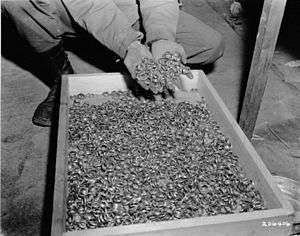Aryanization (Nazism)
| Part of a series on | ||||||||||
| The Holocaust | ||||||||||
|---|---|---|---|---|---|---|---|---|---|---|
 | ||||||||||
|
||||||||||
|
Atrocities |
||||||||||
|
Camps
|
||||||||||
|
Lists Deportations of French Jews
to death camps |
||||||||||
|
Remembrance |
||||||||||
Aryanization (German: Arisierung) is a term coined during Nazism referring to the forced expulsion of so-called "non-Aryans", mainly Jews, from business life in Nazi Germany and the territories it controlled. It entailed the transfer of Jewish property into "Aryan" hands in order to "de-Jew the economy".
Literally, 'aryanization' means "to make Aryan". Fundamentally, the concept was based on the ideology of the "Aryan master race" which was to consider people of Europe Aryans through Germanisation.
The process started by depriving its victims of their wealth and ended with the Holocaust, when it deprived them of their remaining property and their lives.
Exclusion of Jews
Through the Aryan paragraph and the Nuremberg Laws, Jews were early on largely excluded from public life. Reserved areas in the economy had been left to them, which Aryanization was to remove. They were removed from jobs in the public sector, such as the civil service and teaching, and further restrictions were introduced through the Nazi period. Later on, an increasing number were incarcerated in Nazi concentration camps, and finally deported to the east where they were murdered directly in death camps or by being shot by the Einsatzgruppen.
Theft of property
By January 1, 1938, German Jews were prohibited from operating businesses and trades, and from offering goods and services. On 26 April 1938, Jews were ordered to report all wealth over 5,000 Reichsmarks, and their access to bank accounts was restricted. On 14 June 1938, the Interior Ministry ordered the registration of all Jewish businesses. The state set the sales value of Jewish firms at a fraction of their market worth, and used various pressure tactics to ensure sales only to desired persons. Among the largest "Aryanization profiteers" were IG Farben, the Flick family, and large banks. The proceeds from "Aryanized" firms had to be deposited in savings accounts, and were made available to their Jewish depositors only in limited amounts, so that in the final analysis Aryanization amounted to almost compensation-free confiscation.
In the Autumn of 1938, only 40,000 of the formerly 100,000 Jewish businesses were still in the hands of their original owners. Aryanisation was completed with the enactment of a regulation, the Verordnung zur Ausschaltung der Juden aus dem deutschen Wirtschaftsleben (Regulation for the elimination of Jews from German economic life) of November 12, 1938, through which the remaining businesses were transferred to non-Jewish owners and the proceeds taken by the state. Jewelry, stocks, real property and other valuables had to be sold. Either by direct force, by government interventions such as sudden tax claims, or by the weight of the circumstances, Jewish property changed hands mostly below fair market value. Jewish employees were fired, and self-employed people were prohibited from working in their respective professions.
Kristallnacht


After the "Kristallnacht" pogroms, the pressure of Aryanization was drastically increased. On 12 November 1938, Jews were forbidden to function as business managers, forcing Jewish owners to install "Aryan" surrogates. These people, who were often promoted by the party, first took over the office, and soon thereafter usually the whole business. "Compliant Aryans" (Gefälligkeitsarier) were threatened with punishment according to the Regulation against Complicity with the Camouflage of Jewish Firms (22 April 1938). Because the Jews were burdened with heavy payments as "atonement" for the damage done by the SA and antisemitic mobs during Kristallnacht, the selling off of Jewish property was only a question of time. On 3 December 1938, the value of Jewish landed property was frozen at the lowest level, and valuables and jewels were permitted to be sold only through state offices. The impoverishment of the Jewish population caused by Aryanization often stood in the way of its goal — of promoting emigration through persecution — because those affected lacked the means to emigrate. They became victims of the Final Solution. Aryanization combined the racial motives of National Socialism with traditional antisemitic resentments within the middle classes (Mittelstand) and the expansionist tendencies of big business. The fear of being too late to share in the booty produced a fateful coalition of greed, so that little opposition to Aryanization arose. After the war, the Federal Republic of Germany paid restitution for the material losses.
Many important businesses were sold and re-sold in the course of the process, some of which (such as the Hertie department store) played an important role during the post-war Wirtschaftswunder years in West Germany. Victims who were murdered by the Nazis were deprived of their last remaining property such as gold teeth, wedding rings, hair and all clothing.
In a broader sense, the term Aryanisation is sometimes used to refer to eviction of Jewish scientists and people engaged in the cultural sector.
Aryanization in film
- The Shop on Main Street (Obchod na korze) - 1965 Oscar-winning Czechoslovakian film
See also
- Aryan paragraph
- Ethnic cleansing
- Germanisation under the Third Reich
- Kristallnacht
- Nazi gold
- Nazi plunder
- Nazism and race
- Racial policy of Nazi Germany
- Reich Flight Tax
- Wannsee conference
Bibliography
- Christian Zentner, Friedemann Bedürftig (1991). The Encyclopedia of the Third Reich. Macmillan, New York. ISBN 0-02-897502-2
References
External links
- Aryanization on the Yad Vashem website